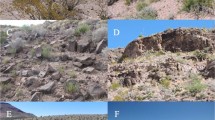Males of the tachinid fly Leschenaultia adusta perch on small trees and shrubs on the highest parts of Usery Peak in central Arizona. Individuals select twig perches on the downwind side of these plants and fly out spontaneously from time to time or in response to another passing insect. Conspecific males elicit chases that on occasion escalate into elaborate, high-speed pursuit flights that go back and forth near the plant for several minutes. Although several males sometimes perch together briefly in the same plant, typically only one individual remains at a site for more than an hour on any given day. These site-faithful males can be considered territorial residents; they constituted about one-quarter of the males marked during the study. More than half of these residents returned to the same perch plant for two or more days. Perch plants varied in their attractiveness to male flies; male preferences were largely consistent across two years of study. Given that females were occasionally observed mating at male-occupied plants, we place the mating system of L. adusta within the hilltopping territorial category in which males compete for landmark perching sites attractive to receptive females. As is true for other hilltopping insects, receptive females of L. adusta appear to be rare and widely distributed.





Similar content being viewed by others
REFERENCES
Alcock, J. (1979). The behavioural consequences of size variation among males of the territorial wasp Hemipepsis ustulata (Hymenoptera: Pompilidae). Behav. 71: 322–335.
Alcock, J. (1981). Lek territoriality in a tarantula hawk wasp Hemipepsis ustulata (Hymenoptera: Pompilidae). Behav. Ecol. Sociobiol. 8: 309–317.
Alcock, J. (1983). Consistency in the relative attractiveness of a set of landmark territorial sites to two generations of male tarantula hawk wasps (Hemipepsis ustulata). Anim. Behav. 31: 74–80.
Alcock, J. (1987). Leks and hilltopping in insects. J. Nat. Hist. 21: 319–328.
Alcock, J., and Carey, M. (1988). Hilltopping behaviour and mating success of the tarantula hawk wasp, Hemipepsis ustulata (Hymenoptera: Pompilidae), at a high elevation peak. J. Nat. Hist. 22: 1173--1178.
Alcock, J., and Kemp, D. J. (2004). Long-term stability in the mating system of the bot fly Cuterebra austeni (Cuterebridae). J. Ins. Behav. 17: 273–280.
Alcock, J., and Smith, A. P. (1995). Landmark-defense and scramble competition mating systems in two Australian tachinid flies (Diptera). J. Kans. Entomol. Soc. 68: 85–94.
Arnaud, P. H., Jr. (1978) A host-parasite catalog of North American Tachinidae (Diptera). USDA Misc. Publ. No. 1319.
Bess, H. A. (1936). The biology of Leschenaultia exul Townsend, a tachnid parasite of Malacosoma americana Fabricius and Malacosoma disstria Hubner. Ann. Entomol. Soc. Amer. 29: 593–613.
Cant, E. T., Smith, A. D., Reynolds, D. R., and Osborne, J. L. (2005). Tracking butterfly flight paths across the landscape with harmonic radar. Proc. Roy. Soc. Lond. B 272: 285–290.
Grenier, S. (1988). Applied biological control with tachinid flies (Diptera, Tachinidae). Anz. Schadl. Pflanz. Umwelt. 61: 49–56.
Hansen, D. E. (2003) Notes on tachinids in copula from hilltops in Carnarvon N.P., Queensland. Tachinid Times 16: 3–5.
Jackson, C. G., Bryan, D. E., Butler, G. D., and Patana, R. (1970). The development, fecundity, and longevity of Leschenaultia adusta (Diptera: Tachinidae), a tachinid parasite of salt-marsh caterpillars (Lepidoptera: Arctiidae). J. Econ. Entomol. 63: 1396–1397.
Lederhouse, R. C., Morse, R. A., Ambrose, J. T., Burgett, D. M., Conner, W. E., Edwards, L., Fell, R. D., Rutowski, R., and Turrell, M. (1976). Crepuscular mating aggregations in certain Ormia and Sitophaga. Ann. Entomol. Soc. Amer. 69: 656–658.
Messina, F. J. (1981). The aggregation behavior of Aplomyiopsis xylota (Diptera, Tachinidae). J. New York Entomol. Soc. 89: 197–201.
Shields, O. (1967). Hilltopping. J. Res. Lepid. 6: 69–178.
Wood, D. M. (1987). Tachinidae. In McAlpine, J. F. (ed.), Manual of Nearctic Diptera, Agriculture Canada Monograph 28, Ottawa, pp. 1193–1269.
Zeigler, J. (2003). Summit conference: hilltopping behaviour of male tachinid flies (Tachinidae) at higher elevations of the European Alps. Tachinid Times 16: 3.
ACKNOWLEDGEMENTS
We thank Jennifer Johnston for helping us gain access to the study site. This work was done while DJK was supported on a postdoctoral fellowship with Ron Rutowski, whose cooperation is appreciated. This paper is partly based upon work supported by the National Science Foundation under Grant No. 0316120 to R. L. Rutowski. Monty Wood graciously agreed to identify several tachinids found on Usery Peak, including L. adusta.
Author information
Authors and Affiliations
Corresponding author
Rights and permissions
About this article
Cite this article
Alcock, J., Kemp, D.J. The Hilltopping Mating System of Leschenaultia adusta (Loew) (Diptera: Tachinidae). J Insect Behav 19, 645–656 (2006). https://doi.org/10.1007/s10905-006-9054-z
Published:
Issue Date:
DOI: https://doi.org/10.1007/s10905-006-9054-z




